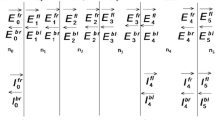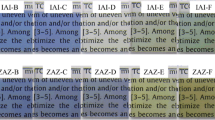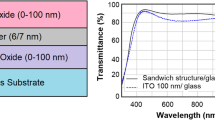Abstract
This work utilized the optical properties of indium tin oxide/silver/indium tin oxide electrodes to set up the fitting range for spectroscopic ellipsometry (SE) analysis. Then, the SE fitting on the thickness and optical constants of each layer in several separate stages was investigated. In this way, the results suggest that the SE fitting can be able to converge rapidly and obtain the precise thickness of each layer. Experiment analysis shows that when the silver layer thickness was 8.5–11.5 nm, the sheet resistance of the uniform electrodes was < 8.5 Ω/sq, while the average transmittances were > 82.0% in the visible light region; the related Haacke indexes were > 22.0 × 10−3 Ω−1. For photovoltaic application, when the silver layer thickness was 7.5–8.5 nm, the sheet resistance of the three-layer electrodes was < 9.0 Ω/sq, while their average transmittance was > 77.5%; the related Haacke indexes were > 9.0 × 10−3 Ω−1. Comparing the SE results with experimental measurements, it is concluded that the uniformity of the silver layer and the stability of the sputtering system were the major factors affecting the optoelectronic performance of the three-layer electrodes.






Similar content being viewed by others
References
K.L. Chopra, S. Major, D.K. Pandya, Transparent conductors—a status review. Thin Solid Films 102(1), 1–46 (1983)
L. Hu, H. Wu, Y. Cui, Metal nanogrids, nanowires, and nanofibers for transparent electrodes. MRS Bull. 36, 760–765 (2011)
J.-Y. Lee, S.T. Connor, Yi. Cui, P. Peumans, S.-P. Electrodes, Nano Lett. 8(2), 689–692 (2008)
J. van de Groep, P. Spinelli, A. Polman, Transparent conducting silver nanowire networks. Nano Lett. 12(6), 3138–3144 (2012)
J. van de Lagemaat, T.M. Barnes, G. Rumbles, S.E. Shaheen, T.J. Coutts, Organic solar cells with carbon nanotubes replacing In2O3: Sn as the transparent electrode. Appl. Phys. Lett. 88, 233503 (2006)
J. Wu, H.A. Becerril, Z. Bao, Z. Liu, Y. Chen, P. Peumans, Organic solar cells with solution-processed graphene transparent electrodes. Appl. Phys. Lett. 92, 263302 (2008)
J. Zou, H.-L. Yip, S.K. Hau, A.K.-Y. Jen, Metal grid/conducting polymer hybrid transparent electrode for inverted polymer solar cells. Appl. Phys. Lett. 96, 203301 (2010)
H. Ferhati, F. Djeffal, A. Benhaya, Optimized high-performance ITO/Ag/ITO multilayer transparent electrode deposited by RF magnetron sputtering. Superlattices Microstruct. 129, 176–184 (2019)
T.-y Wang, B.-J. Li, N.-F. Ren, L.-J. Huang, H. Li, Influence of Al/Cu thickness ratio and deposition sequence on photoelectric property of ZnO/Al/Cu/ZnO multilayer film on PET substrate prepared by RF magnetron sputtering. Mater. Sci. Semicond. Process. 91, 73–80 (2019)
K.-M. Lin, R.-L. Lin, W.-T. Hsiao, Y.-C. Kang, C.-Y. Chou, Y.-Z. Wang, Effects of the structural properties of metal oxide/Ag/metal oxide multilayer transparent electrodes on their optoelectronic performances. J. Mater. Sci. Mater. Electron. 28(16), 12363–12371 (2017)
K. Vedam, Spectroscopic ellipsometry: a historical overview. Thin Solid Films 313–314, 1–9 (1998)
D.E. Aspnes, Expanding horizons: new developments in ellipsometry and polarimetry. Thin Solid Films 455–456, 3–13 (2004)
D.E. Aspnes, Spectroscopic ellipsometry—past, present, and future. Thin Solid Films 571, 334–344 (2014)
M. Losurdo et al., Spectroscopic ellipsometry and polarimetry for materials and systems analysis at the nanometer scale: state-of-the-art, potential, and perspectives. J. Nanopart. Res. 11, 1521–1554 (2009)
E. Garcia-Caurel, A. De Martino, J.-P. Gaston, Li. Yan, Application of spectroscopic ellipsometry and Mueller ellipsometry to optical characterization. Appl. Spectrosc. 67, 1–21 (2013)
Y.S. Jung, Spectroscopic ellipsometry studies on the optical constants of indium tin oxide films deposited under various sputtering conditions. Thin Solid Films 467, 36–42 (2004)
R.A. Synowicki, Spectroscopic ellipsometry characterization of indium tin oxide film microstructure and optical constants. Thin Solid Films 313–314, 394–397 (1998)
J.N. Hilfiker, N. Singh, T. Tiwald, D. Convey, S.M. Smith, J.H. Baker, H.G. Tompkins, Survey of methods to characterize thin absorbing films with spectroscopic ellipsometry. Thin Solid Films 516, 7979–7989 (2008)
J.A. Woollam, Co., Inc. CompleteEASE™ Data Analysis Manual (2011)
Acknowledgements
The authors gratefully acknowledge the financial support provided by the Ministry of Science and Technology of the Republic of China under Contact Number MOST 109-2221-E-218-001.
Author information
Authors and Affiliations
Corresponding author
Additional information
Publisher's Note
Springer Nature remains neutral with regard to jurisdictional claims in published maps and institutional affiliations.
Rights and permissions
About this article
Cite this article
Lin, KM., Shinde, S. Spectroscopic ellipsometry to precisely estimate the thickness for optimizing the performance of three-layer broadband transparent electrodes. J Mater Sci: Mater Electron 32, 5690–5697 (2021). https://doi.org/10.1007/s10854-021-05290-1
Received:
Accepted:
Published:
Issue Date:
DOI: https://doi.org/10.1007/s10854-021-05290-1




